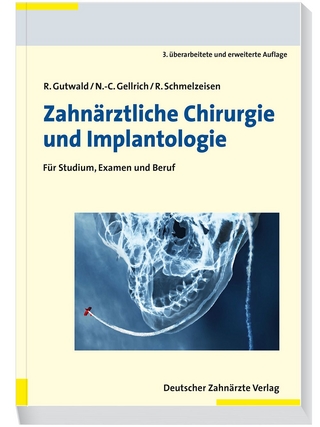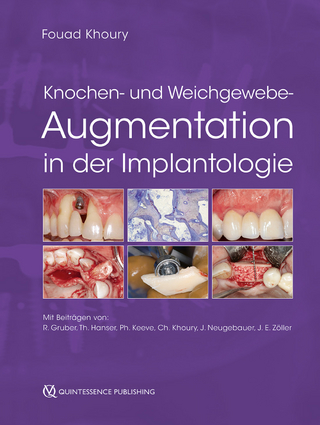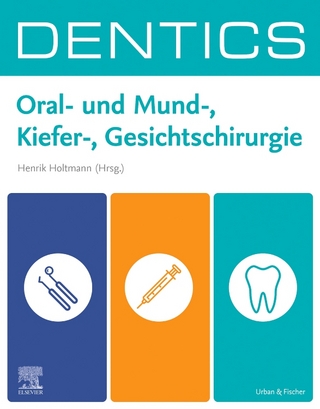
Oral and Maxillofacial Surgery, Medicine, and Pathology for the Clinician
John Wiley & Sons Inc (Verlag)
978-1-119-36149-7 (ISBN)
Clinical scenarios are clearly described with treatment flow paths, and to enable seamless reader comprehension, charts and algorithms also support the text. The text focuses on essential office-related topics that are not esoteric but rather common in occurrence. The highly qualified author speaks directly to topics of interest that will add value to the practitioner’s practice. Major surgical procedures not commonly performed by practicing oral surgeons are not included.
Overall, the text contains important up-to-date information that can be immediately put to use in clinical practice.
»Oral and Maxillofacial Surgery, Medicine, and Pathology for the Clinician« covers sample topics like:
- Patient assessment and significance of medical history review, the need for antibiotic prophylaxis (when, where, and how), and review of local anesthesia
- Diagnosis treatment and prevention of office medical emergencies and stocking in the dental office to deal with emergencies
- Basic review of oral mucosal lesions and treatment, review of antibiotic, oral sedation techniques and IV sedation overview, and basic and advanced exodontia
- Diagnosis/treatment of common post extraction complications and diagnoses and management of acute/chronic oral pain
The full scope of oral surgery is thoroughly covered in this multidisciplinary, current reference, making »Oral and Maxillofacial Surgery, Medicine, and Pathology for the Clinician« an essential tool for oral and maxillofacial surgeons, general dentists, and dental students looking to build upon their foundations of practical knowledge.
Harry Dym, DDS, is Chairman of the Department of Dentistry and Oral and Maxillofacial Surgery at the Brooklyn Hospital Center and Clinical Professor of Oral and Maxillofacial Surgery at Columbia University College of Dental Medicine.
Leslie Halpern, M.P.H., D.D.S., M.A., M.PHIL., M.D., PH.D. is Adjunct Assistant Professor of Otolaryngology-Head and Neck Surgery at University of Utah School of Medicine in Salt Lake City, Utah, United States.
Orrett Ogle, DDS is an Oral & Maxillofacial Surgery Specialist in Brooklyn, New York, United States.
Contributors xix
Preface xxi
Part I Basics 1
1 Patient Evaluation and Management of Medical Problems in the Oral Surgery Patient 3
Risk
Assessment 3
Documentation
4
Management
of Patients with Medical Problems 5
Cardiovascular Disease 6
Hypertension 6
Angina Pectoris 7
Myocardial Infarction 8
Stroke/Cerebrovascular Accident 9
Cardiac Arrhythmias 9
Heart Failure 10
Treatment Guidelines 10
Endocrine Disorders 11
Diabetes Mellitus 11
Thyroid Disease 12
Adrenal Insufficiency 13
Hepatic Disease 13
Renal Disease 15
Dialyzed Patients 15
Pulmonary Disease 15
Asthma 15
Chronic Obstructive Pulmonary Disease 15
Pregnancy 16
Conclusion
18
References 18
2 Risk Reduction Strategies 21
Methods
of Risk Reduction 21
Faulty
Record Keeping 21
Informed
Consent 21
Conclusion
23
References 23
Contents
Dym361497_ftoc.indd 5 8/29/22 8:51 PM
vi Contents
3 Preparing the Dental Office for Medical Emergencies: 25
Staff
25
Equipment
26
Oxygen 26
Airway Adjuncts 26
Automated External Defibrillators (Figure 3.2) 26
Vitals Monitoring 27
Intravenous Kits 27
Emergency
Drug Kit 27
Oxygen 27
Aromatic Ammonia 27
Aspirin 28
Albuterol 28
Glucose 28
Nitroglycerin 28
Diphenhydramine 29
Epinephrine 29
Sedation-Specific Emergencies 29
Summary
29
References 29
4 Infection Control in Dental Practice 31
Why
is Infection Control Important in the Dental Office? 31
Hand
Hygiene 32
Potential
Infectious Diseases in the Dental Office 33
HBV
Vaccination 34
Preventing
Exposures to Blood and OPIM 34
General Recommendations 34
Engineering and Work Practice Controls 35
Postexposure Management and Prophylaxis 35
Handling of Biopsy Specimens 35
Handling of Extracted Teeth 35
Control
of 2009 H1N1 Influenza 35
Vaccination 35
Specific Recommendations for Dental Healthcare 35
Dental Healthcare Personnel 36
Transmission
Risk of Mycobacterium tuberculosis in Dentistry 36
Percutaneous
Injuries among Dental Healthcare Providers 36
Exposure
Prevention Strategies 36
Postexposure
Management 39
Disinfection
versus Sterilization 40
Decontamination
and Disinfection Methods 40
Manual Cleaning 40
Automated Cleaning 40
Sterilization
Methods 40
Instrument
Processing 41
Spore
Testing and Dual Monitoring Strips in Sterilization Bags 42
Proper
Disinfection of Handpieces, Impressions, Environmental Surfaces 42
Medical
Waste Management 43
Dental
Unit Waterlines 44
Infection
Control Program Plan and Goals 44
Conclusion
44
References 45
Dym361497_ftoc.indd 6 8/29/22 8:51 PM
Contents vii
Part II Dentoalveolar Surgery 47
5 Surgical Management of the Impacted Canine 49
Etiology
49
Diagnosis
49
Treatment
and Management of the Impacted Canine 51
Goals 51
Interceptive Treatment to Prevent Impactions 51
Surgical Management of the Impacted Canine 51
Open vs Closed Surgery 51
Palatal Maxillary Impactions 52
Labial Maxillary Impactions 52
Mandibular Impactions 53
Complications
53
References 54
6 Crown Lengthening 55
Biologic
Width 55
Indications
for Crown Lengthening [3] 55
Contraindications
for Crown Lengthening [1] 56
Procedures
Carried Out Prior to Crown Lengthening [4] 56
Bone
Sounding [2] 56
Sequence
of Treatment for Crown Lengthening 56
External Bevel Gingivectomy 56
Internal Bevel Gingivectomy 56
Flap Surgery with Osseous Surgery 57
Apically Positioned Flap With or Without Osseous Surgery 58
Combined with Orthodontic Extrusion 58
Classification
of Esthetic Crown Lengthening [2] 58
Postoperative
Care [3] 59
References 59
Part III Implantology 61
7 Bone-Grafting Techniques and Biomaterials for Alveolar Ridge Augmentation 63
Bone
Graft Materials and Healing Physiology 63
Introduction 63
Bone Graft and Tissue Engineering Materials – Outline 63
Autogenous (Natural) 63
Allograft (Natural) 63
Xenograft – Bovine, Porcine, Equine, Marine Coral, or Algal Sources 63
Alloplast 63
Other Synthetic Sources (Engineered) 64
Autologous Platelet Concentrate 64
Bone Graft and Tissue Engineering Materials 64
Autograft 64
Allograft 64
Mineralized Freeze-Dried Bone Allograft 65
Demineralized Freeze-Dried Bone Allograft 65
Particulate Cortical, Cancellous, and Corticocancellous Allograft 65
Dym361497_ftoc.indd 7 8/29/22 8:51 PM
viii Contents
Xenograft
65
Natural Hydroxyapatite 65
Bio-Oss – Bovine Derived 65
Natural Hydroxyapatite – Marine Coral Derived 65
Calcium Carbonate – Biocoral 65
Fluorohydroxyapatite (FHA) = Natural Sea Algae Derived 66
Alloplast (Synthetic Sources) 66
Hydroxyapatite Based (Synthetic HA) 66
Marine Coral Derived (Hydroxyapatite) 66
Coralline Porous Hydroxyapatite – Interpore (Synthetic HA) 66
Coralline Porous Hydroxyapatite – Pro Osteon (Synthetic HA) 66
Nanocrystalline Hydroxyapatite (Synthetic HA) 67
Tricalcium Phosphate (Synthetic) 67
Biphasic HA and B-TCP Material (Synthetic Combination) 67
Calcium Sulfate – Gypsum Based (Synthetic) 67
Calcium Sulfate – Nanocrystalline (Synthetic) 67
Biphasic Calcium Sulfate (Synthetic) 67
Bioactive Glass Ceramics (Synthetic) 68
Other Synthetic Sources – Recombinant Bone Morphogenetic Protein (rhBMP) 68
Autologous Platelet Concentrates (See Table 7.1 for Complete Formulations) 68
Platelet-Rich Plasma 68
Platelet-Rich Fibrin 68
Ridge
Preservation 70
Ridge Preservation Indications 70
Ridge Preservation Algorithm 70
Ridge Preservation Surgical Technique 71
Ridge Preservation Surgical Complications 73
Ridge Preservation Implant Survival and Success Rates 73
Ridge Preservation Conclusion (Box 7.4) 74
Guided
Bone Regeneration 75
Guided Bone Regeneration Indications 75
Nonabsorbable Membrane 75
Titanium Mesh 75
e-PTFE [51, 52] 75
Nonexpanded d-PTFE (Osteogenics Biomedical) [6, 49–51, 53] 75
Titanium-reinforced PTFE [51, 54] 76
Absorbable Membrane 77
Collagen Base (Bovine, Porcine, or Human Tendon, Dermis, Skin, or Pericardium) 77
Polymeric Membrane (Manufactured Synthetic Membrane) 77
Tuberosity Harvest Technique (Figures 7.9–7.11, Box 7.5) 78
Guided Bone Regeneration 78
Surgical Technique for Three Wall Defect (Figures 7.15–7.18) 78
Surgical Technique for Moderate-to-Severe Defect 78
Particulate Graft Resorption Post Grafting 80
Guided Bone Regeneration Complications 81
Guided Bone Regeneration Implant Survival and Success Rates 81
Guided Bone Regeneration Conclusion (Box 7.6) 81
Intraoral
Onlay Graft 82
Indications (Particulate and Block Graft) 82
Subperiosteal Tunneling Technique with Absorbable Membrane 83
Autogenous Onlay Corticocancellous Grafts Healing 84
Dym361497_ftoc.indd 8 8/29/22 8:51 PM
Contents ix
Surgical Harvest Technique: Intraoral Lateral Ramal Shelf and Symphysis (Figure 7.8) 84
Autogenous Intraoral Block Grafts – Surgical Complications 86
Allogeneic Block Bone (Cadaver Bone) 86
Block Graft Implant Survival and Success Rate 86
Block Graft Conclusion (Box 7.7) 86
Ridge
Split 87
Indications 87
Ridge Split Surgical Technique 87
Ridge Split Complications 87
Ridge Split Implant Survival and Success Rates 88
Ridge Split Conclusion (Box 7.8) 88
Interpositional
Bone Graft or “Sandwich Osteotomy” 89
Indications 89
Interpositional Bone Graft Surgical Technique 89
Interpositional Bone Graft Complications 90
Interpositional Bone Graft Implant Survival and Success Rates 90
Interpositional Bone Graft Conclusion (Box 7.9) 90
Distraction
Osteogenesis 91
Indications 91
Distraction Osteogenesis Surgical Technique 93
Distraction Osteogenesis Complications 93
Distraction Osteogenesis Implant Survival and Success Rates 93
Distraction Osteogenesis Conclusion (Box 7.10) 93
Postoperative
Instructions 93
Conclusion
94
Horizontal Augmentation Recap (Tables 7.5 and 7.6) 94
Horizontal Augmentation Complication Recap 94
Vertical
Augmentation Recap (Tables 7.5 and 7.6) 95
References 97
8 Maxillary Sinus Augmentation 101
Introduction
101
Maxillary
Sinus Anatomy 101
Indications,
Contraindications, Limitations 101
Lateral
Window Approach 102
Transalveolar
(Crestal) Approach 102
Bone-
Grafting Material 103
Complications
103
References 105
9 Technologic, Material, and Procedural Advancements in Dental Implant Surgery 107
Introduction
107
Three-
Dimensional Imaging 107
Computerized
Implant Planning Technology 108
Intraoral
Optical Impressions and Integration with CBCT, CAD/CAM, and Stereolithography 108
Surgical
Drilling Guide Integration and Fabrication 110
Guided
Navigation in Osteotomy Preparation and Implant Placement 110
Membranes
for Bone Grafting 111
BMP,
PRGF, and PRP 112
Implant-
Supported, Full-Arch, Fixed Prostheses with Immediate Loading and “All-on-Four” 113
Zygomatic
Implants 114
Dym361497_ftoc.indd 9 8/29/22 8:51 PM
x Contents
Lasers
115
Conclusion
116
References 116
Part IV Trauma 117
10 Diagnosis and Management of Dentoalveolar Trauma 119
Introduction
119
Evaluation
119
History
119
Physical
Examination 119
Radiographic
Studies 120
Diagnosis
and Management of Dentoalveolar Injuries 120
Injuries
to the Dental Hard Tissue and Pulp 120
Crown Infraction 120
Crown Fracture 120
Crown-Root Fracture 121
Root Fracture 121
Injuries
to the Periodontal Tissues 121
Concussion 121
Subluxation 121
Intrusion 121
Extrusion 122
Lateral Luxation 122
Avulsion 122
Dentoalveolar
Injuries in the Primary Dentition 123
Splinting 124
Injuries
to the Gingiva or Oral Mucosa 124
Injuries
to Supporting Bone 124
Follow-
Up 125
Conclusion
125
References 125
Part V Pathology 129
11 Biopsy Technique: When, Where, and How? 131
Introduction
131
Patient
Evaluation: Health History, Medications 131
Lesion
History 132
Clinical
Examination 133
Indications
for Biopsies 136
Precancerous
Lesion: “Potentially Malignant Disorders” 136
Biopsy
Techniques 139
Incisional Biopsy 139
Excisional Biopsy 140
Punch Biopsy 140
Adjunctive
Techniques 140
Lugol’s Iodine 142
Toluidine Blue 142
Brush Biopsy/Cytology 144
References 144
Dym361497_ftoc.indd 10 8/29/22 8:51 PM
Contents xi
12 Recurrent Lesions of the Oral Mucosa: 147
Introduction
147
Aphthous
Lesions and Recurrent Aphthous Stomatitis 147
Presentation 147
Etiology 147
Diagnosis 148
Treatment 148
Herpetic
Lesions 149
Course of the Disease 149
Diagnosis 149
Treatment 149
Candidiasis
150
Clinical Presentation 150
Diagnosis 150
Treatment 150
Lichen
Planus 151
Clinical Presentation 151
Diagnosis 151
Treatment 151
Pemphigus
Vulgaris 152
Clinical Presentation 152
Etiology 152
Diagnosis 153
Treatment 153
Erythema
Multiforme 153
Clinical Presentation 153
Diagnosis 154
Treatment 154
Fixed
Drug Eruptions 154
Clinical Presentation 154
Etiology 154
Diagnosis 155
Treatment 155
References 155
13 Benign Pediatric Pathology: Diagnosis and Management 159
Introduction
159
Odontogenic
Cysts 159
Periapical Cyst 159
Buccal Bifurcation Cyst 159
Dentigerous Cyst 159
Eruption Cyst 160
Odontogenic Keratocyst 160
Odontogenic Tumors 161
Odontoma 161
Ameloblastoma 161
Ameloblastic Fibroma 162
Nonodontogenic
Cysts 162
Idiopathic Bone Cavity 162
Aneurysmal Bone Cyst 162
Nonodontogenic Tumors 163
Congenital Epulis 163
Melanotic Neuroectodermal Tumor of Infancy 163
Dym361497_ftoc.indd 11 8/29/22 8:51 PM
xii Contents
Juvenile Ossifying Fibroma 164
Fibrous Dysplasia 164
Giant Cell Lesion 164
Cherubism 166
Soft
Tissue Lesions 166
Fibroma 166
Pyogenic Granuloma 166
Branchial Cleft Cyst 166
Hemangioma 167
Vascular Malformation 167
Verrucous Vulgaris and Condyloma Acuminatum 168
Salivary
Gland Lesions 168
Mucocele 168
Ranula 168
Pleomorphic Adenoma 168
References 169
14 Diagnosis and Management of Salivary Gland Pathology 173
Introduction
173
Obstructive
Salivary Gland Disorders 173
Sialolithiasis (Salivary Gland Stones) 173
Etiology 173
Sialolithiasis Imaging 174
Management of Sialolithiasis 174
Bacterial Salivary Gland Infections 175
Viral
Diseases 176
Viral Sialadenitis 176
Granulomatous Disease of the Salivary Gland 176
Autoimmune
Diseases 177
Sjögren Syndrome 177
Salivary
Gland Tumors 177
Pleomorphic Adenoma 178
Warthin Tumor 178
Mucoepidermoid Carcinoma 179
Adenoid Cystic Carcinoma 179
Polymorphic Low-Grade Adenocarcinoma 179
Conclusion
179
References 179
15 Odontogenic Cysts and Odontogenic Tumors 183
Introduction
183
Basic
Embryology 183
Odontogenic
Cysts 183
Odontogenic Cysts of Inflammatory Origin 184
Radicular Cysts 184
Residual Cysts 184
Collateral Cysts 184
Developmental Odontogenic Cysts 184
Dentigerous Cysts 185
Odontogenic Keratocyst (Keratocystic Odontogenic Tumor) 185
Lateral Periodontal Cyst and Botryoid Odontogenic Cyst 187
Dym361497_ftoc.indd 12 8/29/22 8:51 PM
Contents xiii
Gingival Cyst 188
Glandular Odontogenic Cyst 188
Calcifying Odontogenic Cyst 188
Orthokeratinized Odontongenic Cyst 189
Odontogenic
Tumors 190
Ameloblastoma 190
Histologic Features 191
Treatment Considerations 191
Calcifying Epithelial Odontogenic Tumor 191
Clinical Presentation 191
Histologic Features 192
Treatment Considerations 192
Adenomatoid Odontogenic Tumor 192
Clinical Presentation 192
Histologic Features 192
Treatment Considerations 192
Squamous Odontogenic Tumor 193
Clinical Presentation 193
Histologic Features 193
Treatment Considerations 193
Odontogenic Fibroma 193
Clinical Presentation 193
Histologic Features 194
Treatment Considerations 194
Cementoblastoma 194
Clinical Presentation 194
Histologic Features 194
Treatment Considerations 194
Odontogenic Myxoma 194
Clinical Presentation 194
Histologic Features 194
Treatment Considerations 194
Odontoma 195
Clinical Presentation 195
Histologic Features 195
Treatment Considerations 196
References 196
16 Osteomyelitis of the Jaw 199
Classification
199
Demographic
Findings 199
Clinical
Presentation 199
Laboratory
Analysis 199
Radiologic
Evaluation 200
Microbiology
202
Histologic
Findings 203
Treatment
203
Case
Presentations 204
Osteomyelitis of the Maxilla 204
Osteomyelitis of the Mandible 205
References 208
Dym361497_ftoc.indd 13 8/29/22 8:51 PM
xiv Contents
17 Obstructive Sleep Apnea 209
Introduction
209
Etiology
209
Symptoms
210
Pathophysiology
and Related Health Issues 211
Diagnosis
and Classification 211
Treatment
212
Intraoral Devices 212
Surgical Procedures 212
Uvulopalatopharyngoplasty (UPPP) 212
Uvulopalatopharyngoplasty 213
Genial Tubercle Advancement 213
Maxillary-Mandibular Advancement 214
Distraction Osteogenesis 215
Conclusion
215
References 216
18 Temporomandibular Disorders: A Clinician’s Guide for Nonsurgical and Surgical Interventions 219
Introduction
219
Classification
and Diagnostic Evaluation 219
Classification 219
Diagnostic
Evaluation 221
History 222
Physical
Exam 222
Nonsurgical
Treatment Approaches 222
Methods of Therapy 223
Splint Therapy 224
Maxillary and Mandibular Full-Arch Splints 225
Other Reversible Therapeutic Options 225
Nonreversible General Dentistry Methods of Therapy 225
Surgical
Approaches 226
Case
Presentation 232
Conclusion
234
References 235
19 Postoperative Complications in Oral Surgery 237
Complications
Arising During the Procedure 237
Extraction of the Wrong Tooth 237
Teeth Splint Technique 237
Damage to Adjacent Tooth or Structures 238
Root Fracture and Displacement 238
Oroantral Communication 239
Aspiration of Teeth, Instruments, Restoration, or Dental Crowns 239
Nerve Injury 239
Complications
after Oral Surgery 240
Alveolar Osteitis (Dry Socket) 240
Infection 241
Pain, Swelling, and Trismus 242
Bleeding 242
Fracture of Bony Structures 242
References 243
Dym361497_ftoc.indd 14 8/29/22 8:51 PM
Contents xv
20 Odontogenic Infections: Anatomy, Etiology, and Treatment 245
Introduction
245
Definition
245
Microbiology
245
Clinical
Presentation 246
Clinical
Work-Up 246
Physical Examination 246
Radiographic Imaging 247
Procurement of Cultures 248
Pain
Control 248
Treatment
Techniques 249
Alveolar/Vestibular/Palatal Abscess 249
Method 249
Palatal Abscess 250
Method 250
Submandibular/Submental Abscess 250
Method 251
Sublingual Abscess 252
Method 252
Buccal and Midfacial Abscess 252
Method 253
Masticator Space 253
Submasseteric Space 254
Methods 254
Pterygomandibular Space 255
Method 255
Temporal Spaces 255
Method 255
Ludwig Angina 255
Treatment of Ludwig Angina 256
Pericoronitis
256
Antibiotic
Therapy 257
References 258
Part VI Pain Control 261
21 Approaches to the Management of Facial Pain 263
Introduction
263
Epidemiology
263
Neurophysiology
of Orofacial Pain 264
Diagnostic
Approach to Facial Pain Patients 264
Grouping
of Oral Facial Pain 266
Acute Facial Pain 266
Neuropathic Pain 266
Episodic Neuropathic Pain 267
Continuous NP 268
Neurovascular Pain 271
Topical
Medications for Orofacial Pain 271
Topical Anesthetics 271
Lidocaine Patches 271
Dym361497_ftoc.indd 15 8/29/22 8:51 PM
xvi Contents
Proparacaine 271
Streptomycin and Lidocaine 271
Vanilloid Compounds (Capsaicin) 271
Topical NSAIDs 272
Ketoprofen 272
Diclofenac 272
Antidepressants 272
Sympathomimetic
Agents 272
NMDA-
Blocking Agents 272
Botulinum
A Toxin 272
Surgical
Treatment Strategies for OFP 273
Injection Therapy 273
Complications of Injection Therapy 274
Summary
and Future Directions 275
References 275
22 Local Anesthesia: Agents and Techniques 279
Local
Anesthetics 279
Nerve
Block Techniques 280
Maxillary Nerve Blocks 280
Anatomy (Figure 22.1) 280
Greater Palatine Approach 281
High Tuberosity Approach 281
Sigmoid Notch Approach 282
Mandibular Nerve Block 282
Halstead Method 283
Akinosi Technique (Figure 22.6) 284
Gow-Gates Technique (Figure 22.7) 284
Auxilliary/
Supplemental Techniques 285
Intrasulcular Infusion 286
Intraosseous Injection 288
Trigger Point Injections 288
Nasal Spray 289
Reversal
of Local Anesthesia 289
References 290
23 Nitrous Oxide 293
History
293
Properties
293
Use
and Administration 293
Risks
and Concerns 294
Contraindications
294
Interactions
with Other Sedatives 295
Delivery
295
Safety
Mechanisms 295
Monitoring
296
Regulation
296
References 296
| Erscheinungsdatum | 10.07.2023 |
|---|---|
| Verlagsort | New York |
| Sprache | englisch |
| Gewicht | 666 g |
| Einbandart | gebunden |
| Themenwelt | Medizin / Pharmazie ► Medizinische Fachgebiete |
| Medizin / Pharmazie ► Zahnmedizin ► Chirurgie | |
| ISBN-10 | 1-119-36149-4 / 1119361494 |
| ISBN-13 | 978-1-119-36149-7 / 9781119361497 |
| Zustand | Neuware |
| Haben Sie eine Frage zum Produkt? |
aus dem Bereich


